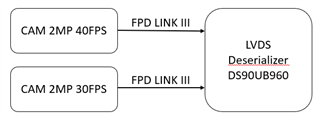Hi Team,
Our Customer have some questions about the DS90UB960-Q1.
1.Two CAM and different frame rates send the video to the DS90UB960.
As shown below, is this method of application possible?

2.As shown below, Two Cam video input to Deserilizer, and the Deserilizer ouput RAW and YUV on a lane.
As shown below, is this method of application possible?

Thanks,
Xiaoxiang

